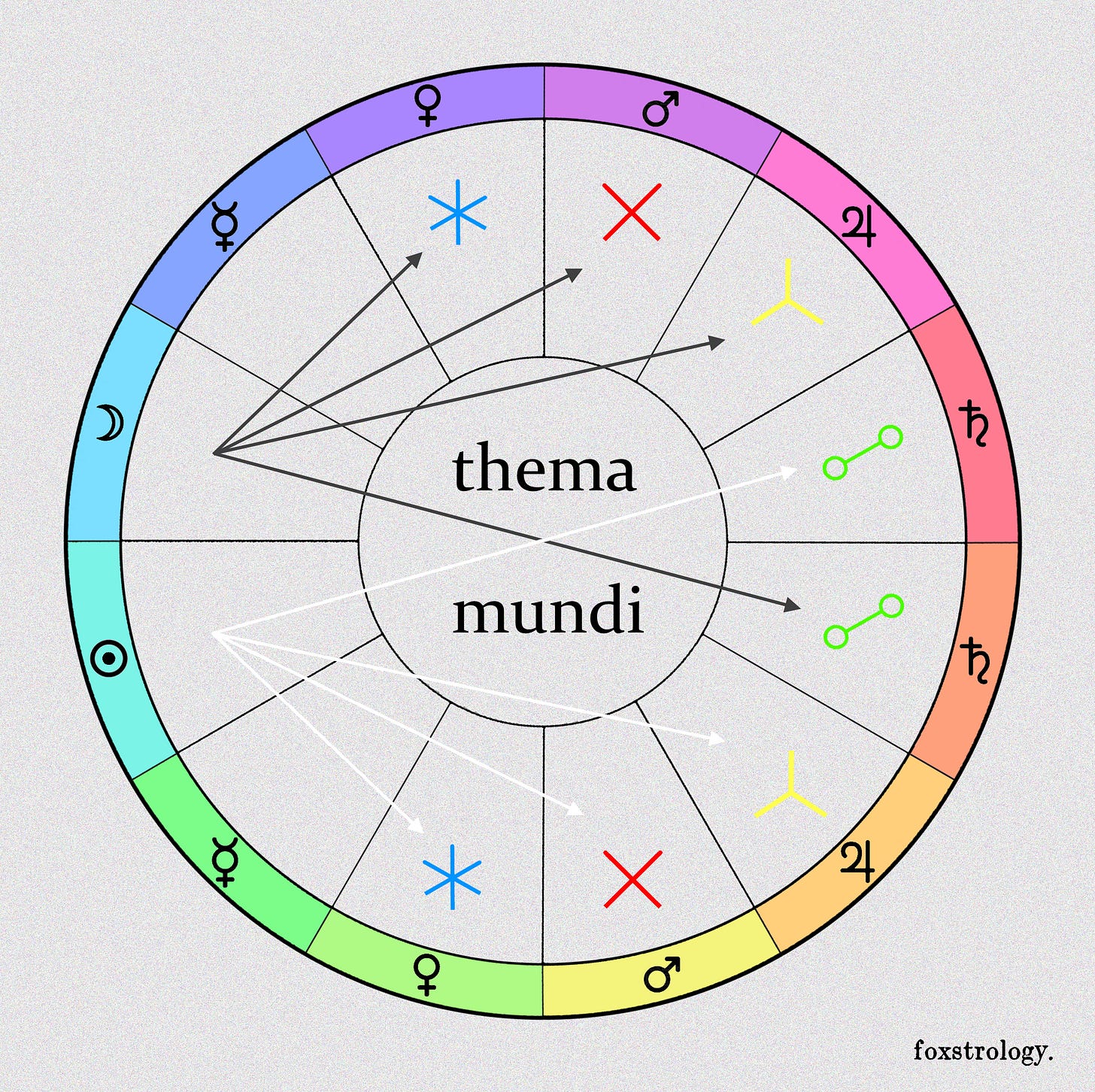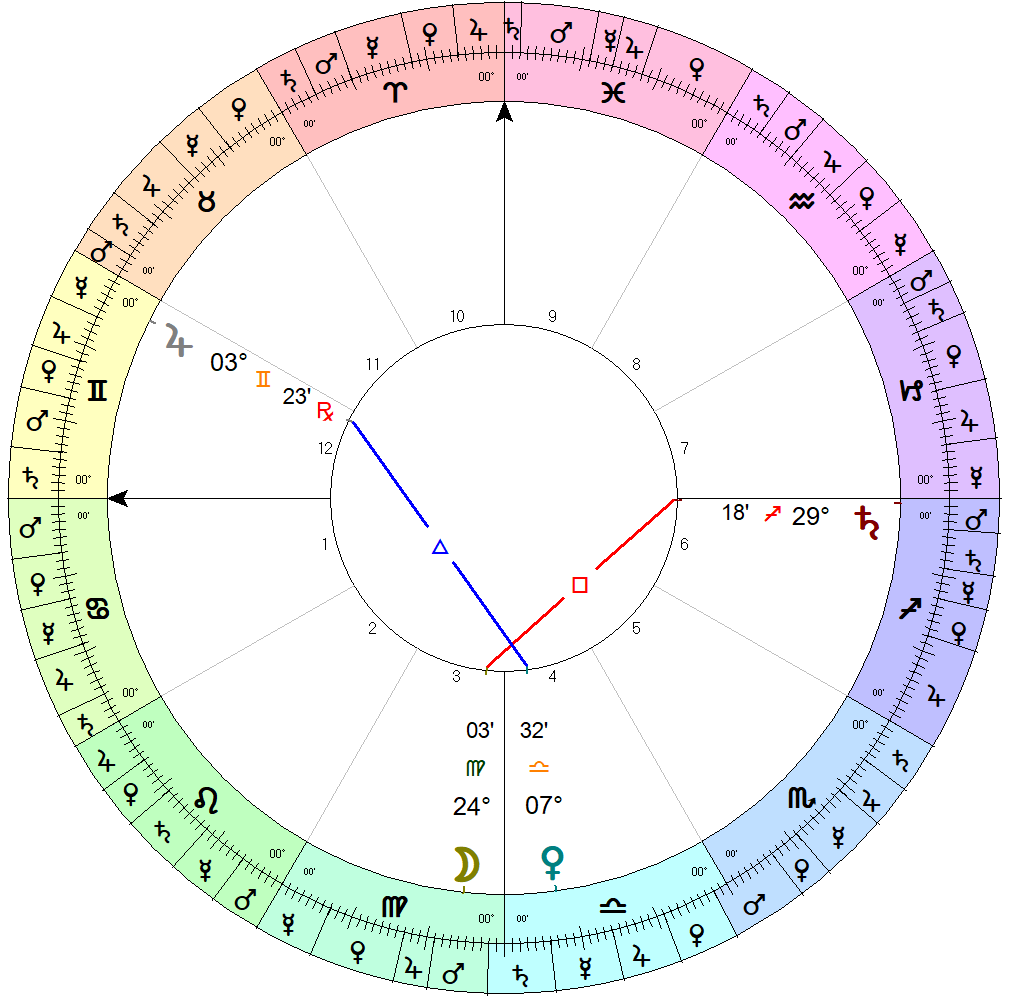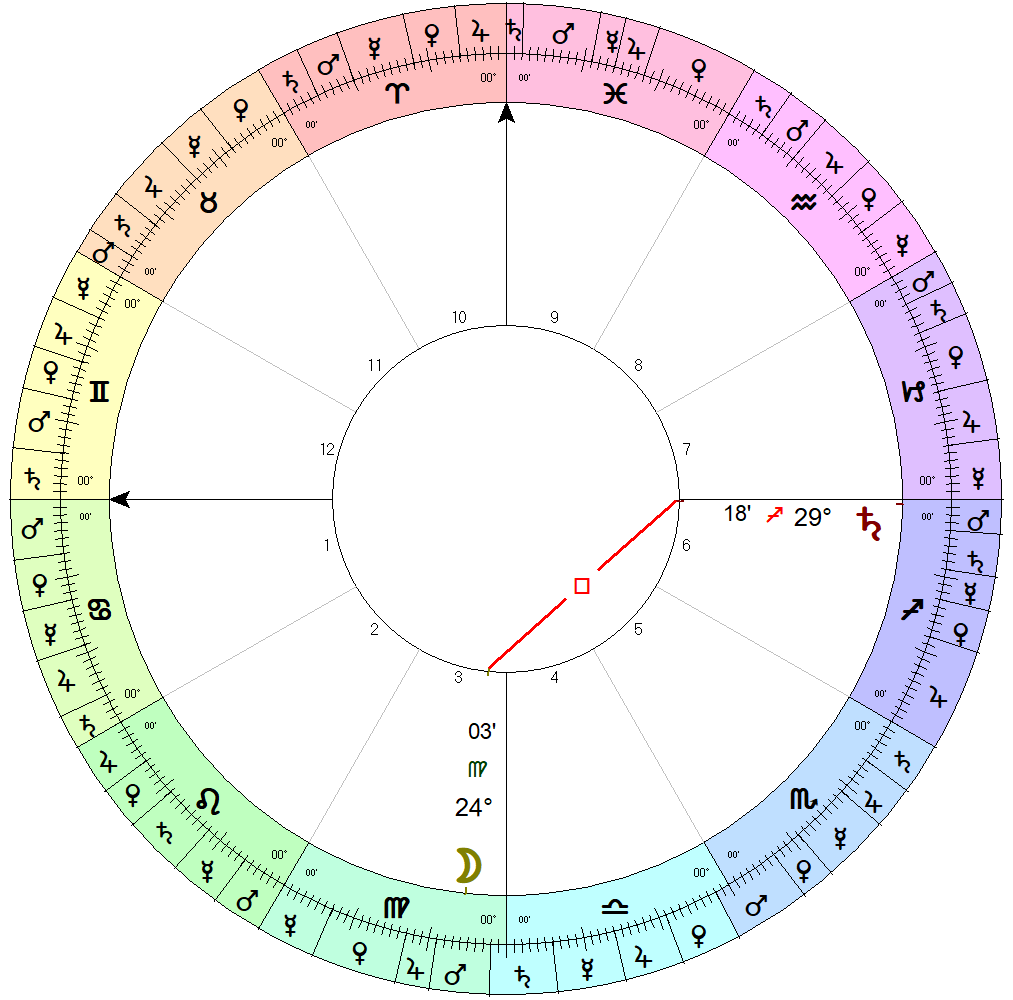aspects
when I started reading charts, I was continually stumped on how to interpret aspects. the issue with aspects is the sheer amount of information you’re working with— you’ve finally figured out how to describe a planet in it’s sign and house placement, and now you have to relate them to another planet in a different sign and house.
should you consider the sign and house placement of both planets? does one planet have more influence than another? is a square from venus good or bad? and what exactly is the difference between an opposition and a square?
it’s a lot to take in, and it’s easy to get lost along the way. I want to share four concepts that helped me simplify the process, and produce deceptively simple interpretations that actually work.
1) the aspects are related to the planets
the first big revelation about aspects is that each one corresponds to a planet!
this correspondence is found in the thema mundi, the mythical birth chart of the universe that was used by ancient astrologers as a teaching tool for important hellenistic concepts.
a refresher on the thema mundi— the thema mundi provides a rationale for the planets’ rulership over their domiciles. it’s ascendant is in cancer, which is given to the moon— from there rulership is given to the planets sign-by-sign in the order of fastest to slowest. at aquarius saturn doubles back, and the order reverses from slowest to fastest. this creates a lovely symmetry, where each planet rules one nocturnal and one diurnal sign.
when you overlay the aspects, beginning at the luminaries, you find that each planet’s domicile has the same aspect to the luminaries. taurus sextiles cancer and libra sextiles leo, so the sextile is said to have the nature of venus, the ruler of taurus and libra. the square has the nature of mars, the trine jupiter, and the opposition saturn. you’ll also notice that the positive aspects are of the nature of benefics and the difficult aspects are of the nature of the malefics. they’re all related!
sextile — nature of venus
square — nature of mars
trine — nature of jupiter
opposition — nature of saturn
have you ever heard that the sextile is just a lesser version of the trine? well, venus is the lesser benefic and jupiter is the greater benefic! the sextile is to the trine as venus is to jupiter. the same goes for the square and opposition.
we can use keywords associated with the planets to interpret aspects. an opposition of the nature of saturn will be restrictive, obstructive, or isolating; a trine of the nature of jupiter will be expansive, opportunistic, or enabling.
2) one planet has more influence than the other
two planets in aspect are in what’s called an “inferior” or “superior” position to each other. this is a hellenistic technique that’s only recently re-entered the astrological lexicon.
the superior planet is in the sign that comes earlier in zodiacal order; the other planet is then the inferior planet.
examples— in a trine between jupiter in gemini and venus in libra, jupiter is in the superior position and venus is in the inferior position because gemini comes before libra. in a square between the moon in virgo and saturn in sagittarius, the moon is in superior position because virgo comes before sagittarius.
you might have guessed it— the superior planet has the greater influence in an aspect. it’s in what’s called the “overcoming” position; and you can use that term to understand how it affects the inferior planet. it literally overcomes it. you can think of the superior planet as particularly persuasive or domineering, urging the inferior planet to follow its lead.
a good way to think about inferior and superior is to consider the difference between the 10th house and the 4th house.
they’re both in a square to the ascendant, but the 10th house is in the superior position and the 4th house is in the inferior position. think of how authority and the public sphere affects us versus how our lineage and the private sphere affects us.
the actions of authority figures and our public image are largely out of our control; they bear down from above. the cultural/social/psychological inheritance of our family and ancestors challenges our self-expression, but we ultimately carry the responsibility of upholding, rejecting, or deconditioning the things inherited from our lineage; we have more agency in our impact as future ancestors.
the one aspect that this concept of inferior/superior doesn’t apply to is the opposition. neither planet in an opposition is superior to the other— they’re at either end of a polarity. this fact in itself is useful in interpretation. oppositions are about balance, dialogue, and boundaries (think saturn!).
3) the signs have their own relationship to each other
an aspect between planets also represents an aspect between signs. I use sign-based aspects and very rarely consider aspects that are out-of-sign, so I find the relationship between signs useful in interpreting aspects.
examples of what I mean by that— a square between the sun in gemini and mars in pisces reflects the inherent square relationship between gemini and pisces; a sextile between the moon in libra and venus in leo reflects the inherent sextile between libra and leo.
to explain this clearly, we need to know what I’ll call the qualities of the signs: their modality, sect, and triplicity/element. as a refresher:
modality is the division of the zodiac into three groups of four signs. these are the cardinal, fixed, and mutable signs. alicesparklykat describes them as sharing similar speed or timing.
sect is the division of the zodiac into two groups of six signs. these are the nocturnal or “feminine” signs and the diurnal or “masculine” signs. (I don’t use gender to describe them; sect works better!) they describe the expression of a sign as directed internally or externally.
triplicity is the division of the zodiac into four groups of three signs. these are the elements of earth, air, water and fire. they describe the tangible or archetypal focus of the signs.
the final differentiating quality of the signs is the planet who rules them, but that isn’t necessary to talk about here. just keep in mind that the ruler also has a huge impact on their signs!
squares— occur between signs in the same modality, and different sect & element.
they’re the only aspect that connects the nocturnal and diurnal signs. we see tension in this conversation between day and night, but also the possibility for generating something new, for learning and growth. these are signs that are trying to do something in very different ways at the same time.
consider aries and cancer— they’re both cardinal signs who are trying to initiate something. aries, as a fiery diurnal sign, is trying to initiate an idea that will outwardly affect the world. it’s a sign of leadership because they’re often trying to do something that’s never been done before, that was born in the fires of inspiration and is now being projected outwards. cancer, as a watery nocturnal sign, is trying to initiate intimate connection that can inwardly sustain themselves and their loved ones. it’s a nurturing sign because they want to gather people together and initiate them into mutual intimacy, creating a container of care for those around them.
you can imagine that if aries is trying to do something bold and new at the same time that cancer is trying to foster connection and intimacy, they’re going to butt heads. the answer can be for one to acquiesce to the other, or, more generatively, for them to recognize the necessity for both to exist and find avenues that allow them to act together to generate a new outcome, one that can only exist through their shared contribution. for cancer and aries, maybe… an activist community!
oppositions— occur between signs in the same modality & sect, and different element.
they actually have more in common than sextiles! the only thing separating them is their element. often the very similarity of opposed signs can be the source of tension between them.
consider virgo and pisces— they’re both story-tellers. they both work in narratives of the world, adapting to their environment and shifting the way stories are told in that container. the tension is in the element, the tangible quality of their work. virgo as an earth sign is focused on the material realm, shifting the details to tell a story better, more succinctly. pisces as a water sign is focused on the ethereal realm, shifting consciousness to tell a story that speaks to your heart, that awakens you to the presence of all things in each other. microcosms and macrocosms.
they’re both trying to tell an inwardly focused story, but in tangibly different ways. because of this, they can have a tense relationship when they’re speaking over each other about who gets to tell the story! the answer is often that both stories are needed, but not at the same time.
sextiles— occur between signs of the same sect, and different element & modality.
this is the aspect of friendship and collaboration. these signs do things in very different ways, but their expression, whether it’s focused inwards or outwards, is aligned.
consider aries and gemini— aries initiates, ignites, and brings leadership, while gemini exchanges, converses, and brings levity. aries is like the friend who decides what bar everyone goes to, buys the drinks and gets the party started, and gemini is the friend who flits around the group, swapping stories and engaging everyone in the conversation.
they embody very different roles in the group, but they work towards the same end of creating an outwardly engaged experience. they feed on each other; they collaborate!
trines— occur between signs of the same sect & element, and different modality.
they’re the only aspect that connects signs of the same element, which will inherently be of the same sect. these are signs that only differ by modality, or timing, which means they take turns. they each have something to add to the complete expression of an element, offering their contribution to the communal work of that element’s archetypal focus. (think jupiter as groups!)
consider taurus and capricorn— nocturnal earth signs whose focus is turned inward and downward, towards the earth. capricorn, as a cardinal sign, wants to initiate projects in the material realm. they have an eye to the past, considering what’s been built before and how to use that to support the long-term stability of what’s initiated now. taurus, as a fixed sign, wants to sustain the existence of things in the material realm. they want to see what’s already been planted come to fruition, and understands the patience and endurance that necessitates. when these two come together, they can produce a bounty that lasts for generations.
they support each other in authentically expressing who they are, and add to that expression in their own time. be aware, however, that this can turn into enabling when the authentic expression of a planet is… destructive, and the planet in trine just adds fuels to the fire. unconditional support can be used both ways, generatively and destructively.
4) aspects will manifest in more than one way
an aspect between planets will have a multiplicity of meanings, not just one. this is the hardest part to understand about aspects— you’ll constantly be discovering new interpretations precisely because they contain so much information.
an aspect will impact both planets’ natural significations, like the moon and emotions; it’ll describe a relationship between houses with the planets as houserulers; it’ll reflect internal states of being and external events that happen at specific times in the life; all at the same time!
example— let’s consider our chart from earlier, with the moon in virgo square saturn in sagittarius.
the moon here represents her natural significations of the body, emotional processing, parents or the mother; as the first house ruler she represents the chart-holder; she’s in virgo, a mercurial earth sign that moves quickly and critically; and her placement in the 3rd house means she’s present in sibling relationships, close friendships, and local travel.
saturn represents her natural significations of isolation, obstacles, slowing down, and responsibilities; as the 7th and 8th house ruler she represents partnerships, contracts, obligations, and other people; she’s in sagittarius, a jupiterian fire sign focused on finding meaning and inspiration; and her placement in the 6th house means she’s present in labor, service, ongoing maintenance and physical health.
interpretation examples— using the natural significations, we could see slowness of the body, distant parents or mother, or impediments to emotional processing. with houserulership we see tension between the chart-holder and their partners or their obligations to others, where the partner or other person represents an obstacle or limitation. when this aspect is activated through timing techniques, we could see external events like health problems, isolation from parents, siblings or friends, limited mobility, or going through a break-up.
a natal chart has a limited number of possible aspects, so every aspect carries a lot of weight. to understand just one outcome of an aspect, you’ll have to narrow the scope of possibility by focusing on one of the things mentioned above— the natural significations, the houses, internal states of being or external events. as long as you have clear expectations you’ll find that aspects are deceptively simple.
a note on conjunctions
are conjunctions an aspect? technically, no. (this is a contentious point in astrology!) we can’t apply planetary nature, superior position, or sign-based relationships to conjunctions because they don’t relate to any planets in the thema mundi, they won’t be in earlier or later signs relative to each other, and they’re in the same sign. the conjunction is a unique condition, and I might explore it in a separate article.
the four principles
to review, we can use these principles to interpret aspects:
the planetary nature of an aspect
the superior or overcoming position of one planet
the sign-based relationship of the aspect
expecting more than one outcome from an aspect
I hope this provides you with a solid foundational framework to simplify your interpretation of aspects. apply these principles to your natal chart or the sky of the moment, and please share your revelations in the comments!



